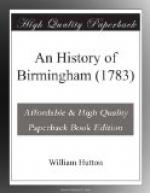There is a road, where foot seldom treads, mounded on each side, leading over the Coldfield, from Perry-bridge towards the Newlands, undoubtedly the work of this venerable band of discreet knights.
The stranger, of course, would deem the property between the contending parties, of great value, which, twenty-four of the principal characters of the age, the flower of two counties, marshalled by two chief officers, were to determine. But what will he think of the quarrelsome spirit of the times, when, I tell him, it was only a few acres, which is, even at this day, waste land, and scarcely worth owning by either.
In 1290, Witton was the property of William Dixley; in 1340, that of Richard de Pyrie, descendant of him, who, a hundred years before, held the contest. In 1426, Thomas East, of Hay-hall, in Yardley, was owner; who sold it to John Bond, of Ward-end, of whose descendants William Booth purchased it, in 1620: an heiress of Booth brought it by marriage to Allestree, of Yardley, who enjoyed it in our days; it was sold to John Wyrley, and is now possessed by George Birch, Esq; of Handsworth.
The house, left by its owners, is in that low, or rather boggy situation, suitable to the fashion of those times. I can discover no traces of a moat, though there is every conveniency for one: We are doubly hurt by seeing a house in a miserable hole, when joining an elegible spot.
BLAKELEY.
Five miles north-west of Birmingham, is Blakely-hall, the manor house of Oldbury. If we see a venerable edifice without a moat, we cannot from thence conclude, it was never the residence of a gentleman, but wherever we find one, we may conclude it was.
Anciently, this manor, with those of Smethwick and Harborn, belonged to the family of Cornwallis, whose habitation was Blakeley-hall: the present building seems about 300 years old.
The extinction of the male line, threw the property into the hands of two coheirs; one of whom married into the family of Grimshaw, the other into that of Wright, who jointly held it. The family of Grimshaw failing, Wright became then, and is now, possessed of the whole.
I am unacquainted with the principal characters who acted the farce of life on this island, but it has long been in the tenancy of a poor farmer, who, the proprietor allured me, was best able to stock the place with children. In 1769, the Birmingham canal passing over the premises, robbed the trench of its water. Whether it endangers the safety is a doubt, for poverty is the best security against violence.
WEOLEY
Four miles west of Birmingham, in the parish of Northfield, are the small, but extensive ruins of Weoley-castle, whose appendages command a track of seventeen acres, situate in a park of eighteen hundred.
These moats usually extend from half an acre to two acres, are generally square, and the trenches from eight yards over to twenty.




